Content
Pozharsky's bell (Campanula poscharskyana) is a herbaceous perennial from the huge Kolokolchikov family, numbering more than 400 species. Unpretentious plants can be found everywhere - in rocks and sandy areas, in alpine meadows and in forests. The name comes from the characteristic shape of the bell-like rim. Breeders have bred many decorative types of bells, distinguished by extremely attractive external data and a delicate aroma of flowers. They are readily used to decorate house plots, decorate flower beds, terraces, gazebos.
Description of the Pozharsky bell
Pozharsky's bell was first found in the mountains of the Balkan Peninsula by the German botanist Pozharsky. It is a low-growing plant, not exceeding 18-25 cm in height. Shoots are long, up to half a meter, spreading along the ground or hanging down if the plant is used as an ampelous plant. The leaves are not large, resemble a heart in shape, serrated at the edges, rich emerald color. At the ends of the shoots, Pozharsky's bell produces numerous buds. The blossoming corollas are large, up to 2.5 cm in size, in the form of long-petaled stars with five rays. Color - light lilac, milky white, deep violet, blue, pinkish. At the end of flowering, fruit-boxes with small spherical brown seeds are formed.
With proper care and sufficient nutrition, Pozharsky's bell grows sprawling, like a ball, strewn with star-shaped flowers. Feels great in the sun and in partial shade, under the crowns of trees or bushes. He does not like drafts and strong winds, so it is worth considering protection from them. Flowering begins in July and lasts until the end of August. The aroma is very subtle and pleasant. It is a great honey plant that attracts bees. The bell withstands dry periods well, frost-resistant varieties can be left in the open field without additional shelter at temperatures down to -40 degrees.
Only a photo can describe the beauty of Pozharsky's bell.
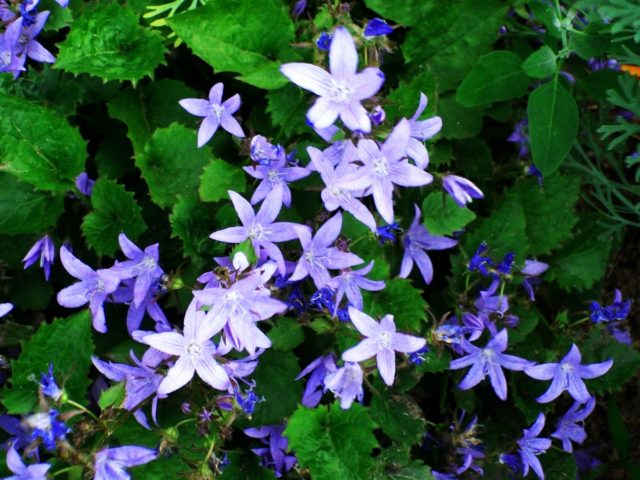
The aroma of Pozharsky's bell is reminiscent of the freshness of young grass and a blooming mountain meadow.
Application in design
The adorable flower is widely used by flower growers to create a wide variety of landscape masterpieces. And the versatility of the plant is of great importance here. The Pozharsky bell can be planted in open ground, in flowerpots and hanging pots. It is magnificent on alpine slides, rocky compositions, in flower beds and in combination with other plants and flowers.
Pozharsky's perennial bell feels great surrounded by saxifrage, small conifers, and carnations. Looks good with roses, sage, phlox and chickweed. Can compose a composition with lupins, loosestrife, crown lichen, nivnyak. A good solution would be a composition of multi-colored bells that create a stunningly beautiful colored carpet. In partial shade, it will keep company with ferns, mountain dwellers, hosts, astilbe.
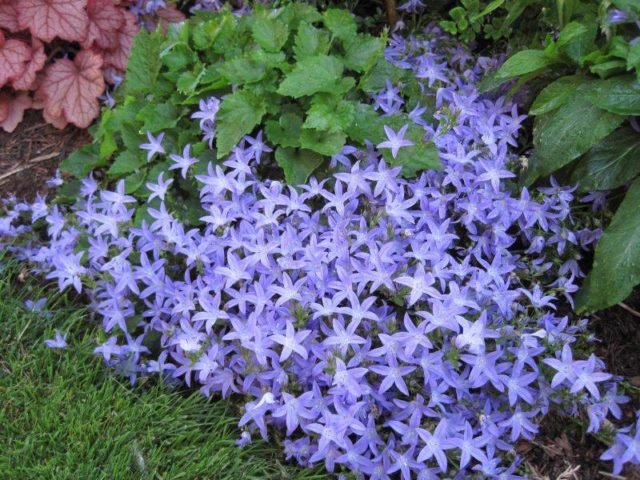
A bright flower ball looks great on ordinary lawn grass, surrounded by greenery
Reproduction methods
The Pozharsky bell is usually grown from seeds, which can be purchased at any specialty store, or harvested from bushes as they ripen in the fall. In addition, perennials can be grown vegetatively:
- Separation of the bush in the spring. The plant is carefully removed from the ground, long shoots are cut off, and the rhizome is divided into several parts, which are then planted in the soil.
- Cutting of Pozharsky's bell with young shoots with 5-6 leaves. The cut parts of the stems must be freed from the foliage by half the length, treated with "Kornevin" and planted in a sterile soil under a film or glass until rooting.
Planting and caring for the Pozharsky bell
This perennial does not require much care or experience. Even novice flower growers successfully create compositions from Pozharsky's bell on their flower beds.
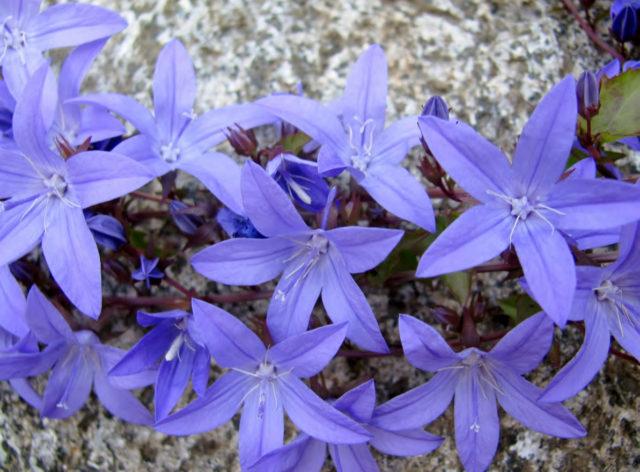
Pozharsky's bell is not whimsical at all, at the same time it is stunningly beautiful
Timing
For seedlings, seeds must be sown in March. If the planting of Pozharsky's bell is planned immediately in the open ground, then it is permissible to do this in the fall, when the temperature drops below 5 degrees, or in May, in the warmed-up soil.
Selection of containers and soil preparation
Seedling containers should be wide and shallow. These can be wooden and plastic boxes with drainage holes. Purchased soil from well-known companies can be used without prior preparation. If you plan to prepare the soil mixture yourself, then you will need to follow a number of rules:
- for planting Pozharsky's bell seeds at home, you need a light, nutritious soil, consisting of humus, sod land and coarse river sand in a proportion of 3x6x1, while there is no need to make additional fertilizers;
- the earthen mixture must be sieved, getting rid of pests, worms, stones and large lumps;
- disinfect with manganese solution, calcining on fire or copper-based antifungal agents.
Seeding Algorithm
No additional preparation is required for the seeds of Pozharsky's bell before planting. Since they are very shallow and cannot be buried, the seed should simply be spread evenly over the surface of the box. After that, gently spray from a spray bottle, cover with glass or film. Put in a warm place at t 18-20 degrees.
Growing seedlings of Pozharsky's bell
The first shoots appear in 2-3 weeks. As soon as this happens, the glass should be removed, and the boxes should be transferred to light, but not in direct sunlight. Young Pozharsky bells require regular, not too abundant watering, and light periodic loosening.
Seedlings dive upon the appearance of two true leaves, transplanting into large containers at a distance of at least 10 cm.Or you can take separate peat pots to simplify the subsequent planting in the ground.
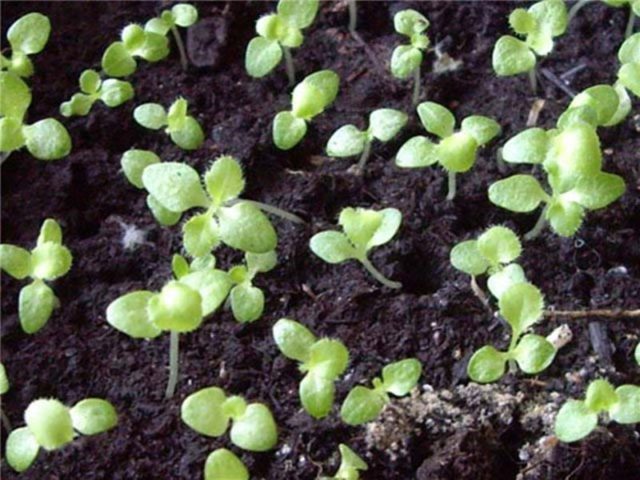
2 weeks after transplanting, the plants can be fed with a weak solution of biofertilizer for flowers.
Transfer to the ground
In open ground, seedlings can be transplanted in May, when the air and soil are warm enough. Holes for the Pozharsky bell are dug at a distance of 15 cm, choosing well-lit places, covered at noon by the shade of trees, buildings, tall shrubs.
Follow-up care
Pozharsky's bell perfectly tolerates the summer heat with daily moisture. But the plant should not be poured - the roots may rot, the leaves may turn yellow.
In order for the bush to please the eye with abundant flowering, the faded buds must be removed. In the spring, you can add a little wood ash or complex nitrogen fertilizers. After watering and loosening, the soil around the bushes is mulched with humus, chopped straw, and coniferous bark. When the first buds appear, the flowers can be fed with a mineral complex for garden plants.
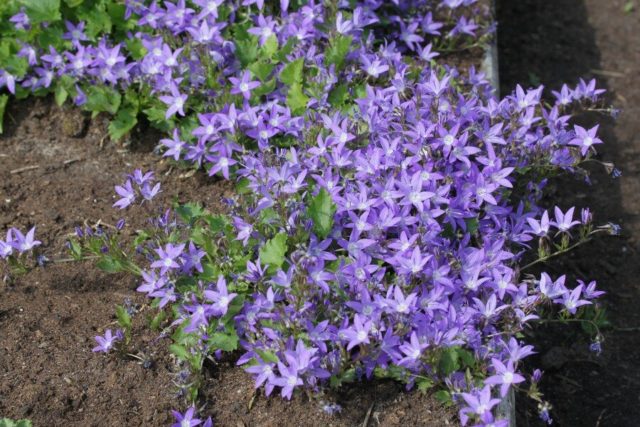
Weeding of perennials is carried out as needed, simultaneously with light loosening
Preparing for winter
Pozharsky's bell is distinguished by excellent resistance to winter frosts, so preparation for winter consists in removing the aboveground part of the plants and mulching the soil with humus, straw, cones or bark. No additional cover is needed.
Diseases and pests
Pozharsky's bell is resistant to bacterial and fungal infections. For prophylaxis, minimal treatments with Fundazol solution are sufficient twice a year - in spring and autumn.
Although the flower is not very susceptible to insect attacks, it can still be chosen by pennies or slugs. Spraying Pozharsky's bell with infusions of bitter pepper or garlic will help scare off these garden insects.
Conclusion
Pozharsky's bell surprises with its fragile beauty. This perennial looks great both in mono compositions and in combination with other garden plants and trees. It is not afraid of Russian frosts, it perfectly tolerates temperature changes and is not too picky about the composition of the soil. It is for its appearance and unpretentiousness that the bell fell in love with flower growers, becoming one of the most popular in Russia.
https://youtu.be/9OM6N1BLyNc








